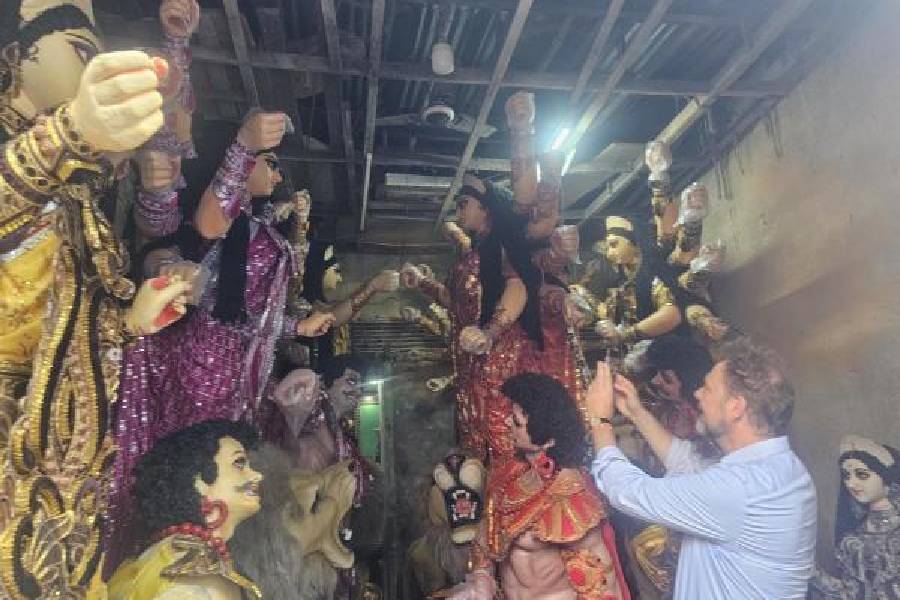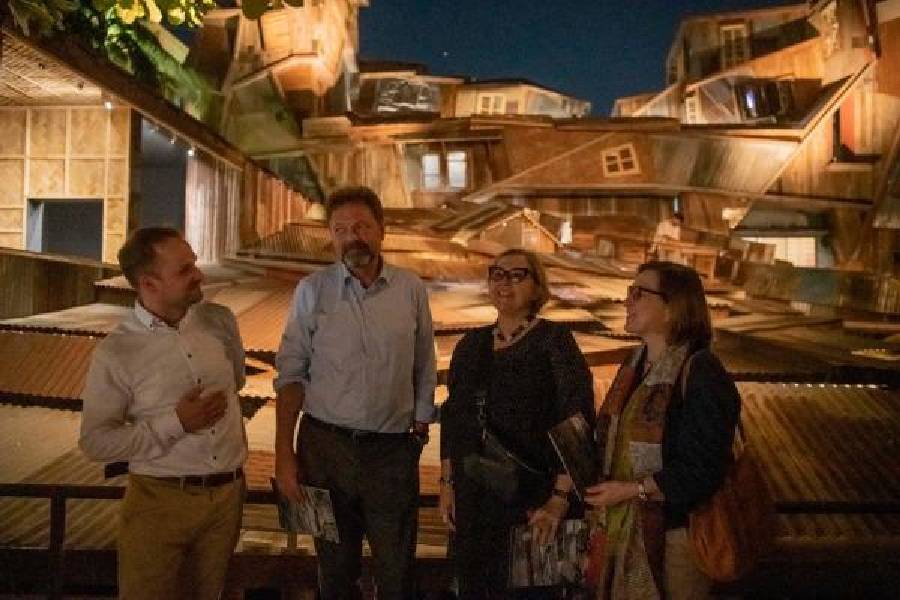German ambassador Philipp Ackermann immersed himself in Durga Puja art, following the stages of the making of the idol at Kumartuli accompanied by The Telegraph and visiting some of the pandals as part of the Preview Show. In between, he also inaugurated an Indo-German collaborative effort, a sound and light installation at Town Hall. He spoke to The Telegraph about his experience...
You seemed to enjoy your tour of Kumartuli.
I’m hugely impressed by this potters’ colony that exists for centuries and carries on the tradition from father to son. I loved the old style of putting clay coming from the river on a straw base and crafting this beautiful image of the Goddess in various forms. It’s very interesting to see how stylistic it can be, and the ingenuity and the creativity involved in depicting Durga in so many ways. It’s almost touching to see how long this tradition has been going on, centred on the main festival of the city.

Philipp Ackermann in Kumartuli.
Do you see any parallels back home or in any of the countries you have been posted in?
There’s one thing in Germany which has a bit of it and I say ‘a bit’ with a lot of caution. There is the preparation of the carnival cortege for the big parade. For months, people prepare this big float depicting big scenes. But otherwise, this festival has a very religious connection while the carnival is more political and has more to do with entertainment. So I think they are not to be compared. It is interesting that there are also Muslim-led clubs which are organising Durga Puja, which makes it very evident how entrenched Islam and Hinduism are socially in West Bengal. It is a unique festival and I have not seen anything similar elsewhere in the world. Next to this traditional way of setting up the pandals and worshipping Durga, you have these modern art installations drawing attention to problems. We saw this banner (of Beleghata 33 Palli puja outside Kumartuli) which raises awareness about glaciar melting through climate change.
You took part in the Durga Puja Art Preview Show tour, organised by massArt, and went to four pandals, starting with Arjunpur Amra Sabai. How was the experience?
Yes. The first one (Arjunpur Amra Sabai) was very strong and had a political message. It was visible from the big statue of Durga that she is a fighter for the downtrodden. The landscape of the roofs rising on the other side (of the pandal) where the civil servants sat and stamped things, reminded me of a Brechtian theatre stage and also of German films of the ‘20s — Fritz Lang and expressionist cinema. It was a message in support of those discriminated against. I had a word with the artist (Bhabatosh Sutar). I was also amazed at how the neighbourhood supported him. They had their houses disguised — you could see the windows half-opened. I understand that Arjunpur is not a neighbourhood where people normally go. It’s moving that the whole neighbourhood liked the puja so much that they came together and became part of it, even financially.

Ackermann at Arjunpur Amra Sabai puja with consul general Barbara Voss and Goethe Institut director Astrid Wege (right)
You went to some Dum Dum Park pujas as well.
I learnt about the women who were training in Subhas Chandra Bose’s regiment and was impressed by the women liberator approach (at Dumdum Tarun Dal). In India, it is all about the men and the armed groups. We forget the women in the fight for Independence. The artist (Pradip Das) made it clear to me. I liked his way of putting images of women on lighted cans and the arrangement of wooden and metal bags (that the women soldiers carried). Durga herself is a strong woman in this circle of women freedom-fighters. She is surrounded by books with holes where guns would be hidden. Architecturally this was also very good.
After these two political ones, there was this philosophical one (at Dum Dum Park Bharat Chakra) of the Brahmin and the raja pulling strings, with Durga in the middle. We want to control the Gods but we can’t. The message was the Gods have us in their grip and not the other way round. Aesthetically, it was beautiful — the jute trees, the jute crown and all these puppeteers. The message was more philosophical than political.
Where else did you go?
The Tala (Prattoy) one was overwhelming. It was so big! What was intriguing was the fact that you have the architecture of the palace but it is all airy. The filigree and metal work creates an illusion of architecture without being architecture. So you’ve the feeling that you went into a palace but at the same time you were in an open space. I found it very very elegant and extremely seducing in the way it is playing between open space and the closed palace.
The artist (Sushanta Paul) took us from room to room, showing us his living room, dining room, his study, his washroom... his bed is there and he sleeps there in spite of all the visitors coming all night. Then you see Durga and the kids and their bed, as obviously she would stay there for the next 10 days. I think that was a very personal pandal that was kind of a jubilee of his years of pandal-making. It was his home that he mirrored in this palace architecture, which I found enchanting and mysterious. You have this beautiful Nataraj in one corner and then you turn around and see the shadow of Nataraj against the wall. It was beautiful. You need to understand the artist’s involvement with the whole puja. He had put up photos of his colleagues, the 30 people who built the palace. What a pity that it goes away after two weeks! I find it very interesting what all the artists said — that it is a thought and when it (the pandal) goes away the thought will still be there. It is a philosophical way of saying there is no need to keep everything as the thought has been put on earth and it will last forever.
You also inaugurated an exhibition that was an Indo-German collaboration at Town Hall as part of the Preview Show.
It was very beautiful and harmonious with the sound and the light — like a meditation. I felt relaxed. I am happy that we had the money to finance (visual designer) Thomas (Eichhorn)’s stay here and his collaboration with Sukanta (Majumdar, sound designer). I wish some German words had been used along with the Bengali words (in the audio-visual installation). This is an area to be explored in the next Durga Puja when you can make some installations between foreign and Indian artists. I also met the craftsmen and women (at Town Hall) and got some stuff for my people in Delhi who have no clue about Durga Puja — small necklaces with the face of Durga, very beautifully hand-painted by a woman artiste with whom I interacted a bit.
What would you say about the Preview Show idea?
I am told that there are about 100 high-grade artistic ones (pandals) in the city. That number is good enough (to visit) for a week! There is room for more international traffic. What you need is an infrastructure for international visitors. For that, you need mapping, a shuttle service to take tourists from pandal to pandal, and explanations and tours. You’d be surprised at how much of an international crowd you can attract with these installations. This is something unique and it’s a complete discovery for me. It’s a hidden secret which needs to be brought out in the open. But there is some logistic work also to be done. I’ll be coming again next year and bringing some guests.
Pictures: Sudeshna Banerjee










